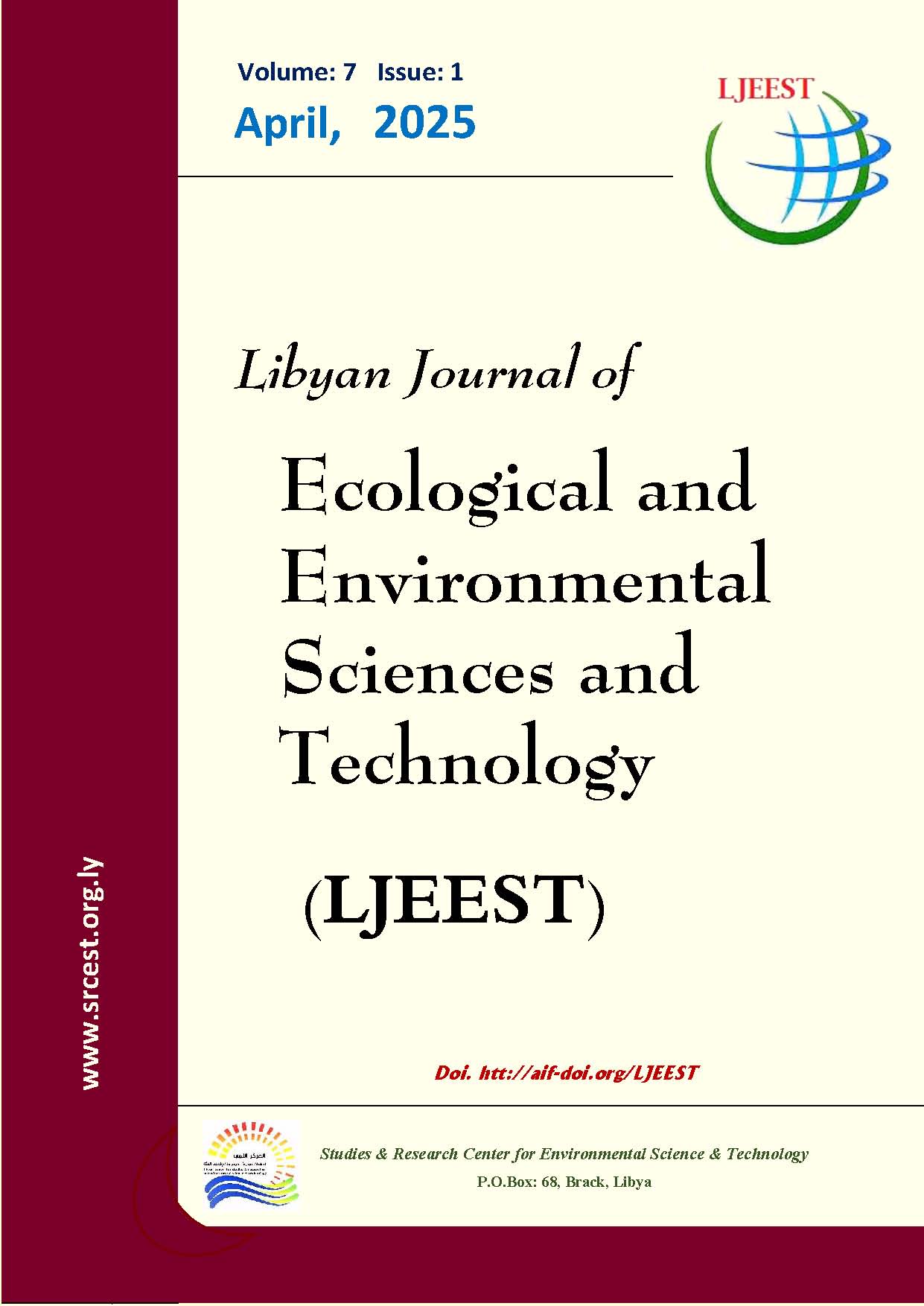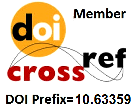Bird Diversity in Some Wetlands of Benghazi, Libya
DOI:
https://doi.org/10.63359/21rasb51Keywords:
Birds, wetlands, diversity, abandance, BenghaziAbstract
Libya is characterized by a great diversity of wetlands, in general, most of the wetlands in Libya are in the form of very shallow, saline or open basins, which are dry or semi-dry most of the year and sometimes connected to the sea (sabkhas), most of which attract different species of birds. This study aimed to classify the study areas according to the criteria of the Ramsar Convention on Wetlands and to identify the bird species that existed in the areas during the seasons, as well as to determine the status of the species in terms of threatening. This study was conducted during the period from January to December 2023, included three wetlands (July 23 Lake, Julyana Lake and Qanfudah Sabkha) in the city of Benghazi. It was found that Julyana Lake and July 23 Lake are classified under type J: coastal salt lakes, while Qanfudah Sabkha is classified under type R: seasonal salt lakes and flats. This study recorded a total of 47,680 birds belonging to 96 species, 67 of which were aquatic and 29 non-aquatic. Julyana lake was distinguished as the highest diversity compared to the rest of the study areas, while Qanfudha area was the highest in abundance. This study recorded significant differences in the numbers of bird species between the seasons of the year in the study areas, where fall season was the highest in diversity, while winter was the least diverse. During this study, a total of twenty-one endangered species were recorded.
References
Azafzaf, H., Baccetti, N., du Rau, P. D., Dlensi, H., Essghaier, M. F., Etayeb, K., Hamza, A. and Smart, M. 2005. Report on an Ornithological Survey in Libya from 3 to 17 January 2005. Cyclostyled report to Regional Activities Centre/Special Protected Areas (MAP/UNEP), Environment General Agency (Libya) and African-Eurasian Waterbird Agreement (UNEP/AEWA).
Azafzaf, H., Baccetti, N., du Rau, P. D., Dlensi, H., Essghaier, M. F., Etayeb, K., Hamza, A. and Smart, M. 2006. Report on an Ornithological Survey in Libya from 19 to 31 January 2006. Cyclostyled report to the Regional Activity Centre/Special protected Areas (MAP/UNEP), Environment General Agency, Libya and to the African-Eurasian Waterbird Agreement (UNEP/AEWA).
Baker, M. C. 1979. Morphological correlates of habitat selection in a community of shorebirds (Charadri-iformes). Oikos 33: 121-126.
Blinkova, O., and Shupova, T. 2017. Bird communities and vegetation composition in the urban forest ecosystem: correlations and comparisons of diversity indices. Ekológia (Bratislava) 36 (4), 366–387. doi: 10.1515/eko-2017-0029.
Bourass, E., Baccetti, N., Bashimam, W., Berbash, A., Bouzainen, M., De Faveri, A., Galidan, A. M. Saied, J. Yahia and Zenatello, M. 2013. Results of the seventh winter waterbird census in Libya, January-February 2011. Bulletin of the African Bird Club, 20, 20-26.
Chamberlain, D. E., Gough, S., Vaughan, H., Vickery, J. A., and Appleton, G. F. 2007. Determinants of bird species richness in public green spaces. Bird Study, 54(1), 87–97.
Cox, R. R., Jr. M. A. Hanson, C. C. Roy, N. H. Euliss, Jr., D. H. Johnson and M. G. Butler. 1998. Mallardduckling growth and survival in relation to aquatic.
Defos, P.D.R., Essghaier, M.F.A. and Etayeb, K.S. 2001. Preliminary survey of coastal wetlands of Libya, Office National de la Chasse et de la Faune Sauvage, France and Environment General Authority - Libya (report 1).
EGA-RAC/SPA waterbird census team 2012. Atlas of wintering waterbird of Libya, 2005-2010. Imprimerie COTIM, Tunisia.
Elbabour M.M., Abdulsamad, E.O., Juliana Lake: A Wetland in an Urban Environment. Libyan Journal of Science and Technology 7:2, 2018. Libya Today, The Pollution in 23rd of July Lake. Libya Today Journal, June 11, 2008.
Etayeb, K., Ashraf Galidana, Ali Berbash, Adulnasser Eisa, Ali Al-kordi, Elias Al-Helali, Mahmoud Abuhajar, Abdulati Alswyeb, Hussien Abdulqader, Naders Azabi, Nader Ghriba, Saleh Deryaq, Abdulhafiz Algnaien, Saleh Buirzayqah, Murad Buijlayyil, Muhanad Bujazlya, Abdulmajid Hamhoom, Abdulmoula Hamza, Ehab Sharif, Abdunaser Dayhum, Abdulwahab Kammon and Ibrahim Eldaghayes. 2023. Results of the eighteenth winter waterbird census in Libya in 2022. Open Veterinary Journal, Vol. 13(4): 407–418. ISSN: 2218-6050 (Online).
Etayeb, K. S., Berbash, A., Bashimam, W., Bouzainen, M., Galidana, A., Saied, M., Yahia, J. and Bourass, E. 2015. Results of the eighth winter waterbird census in Libya in January 2012. Biodiversity Journal, 6 (1): 245–252.
Etayeb, K., Essghaier, M. F., Hamza, A., Smart, M., Azafzaf, H., du Rau, P. D., and Dlensi, H. 2007. Report on an Ornithological Survey in Libya from 3 to 15 February 2007. Cyclostyled report to the Regional Activities Centre/Spl Protected Areas (MAP/UNEP) and Environment General Authority, Libya.46pp.
Etayeb, K., Yahya, J., Shomany, K., Algnaien, H., and Hamza, A., 2012. Report on restorantion and extension of lake Jeliana islet Technical Report. Initiative PIM 3,4,6pp
Gaskell, J. 2005. Recent changes in the status and distribution of birds in Libya -Sandgrouse. 27(2): 126-138.
Hamza, A., Baccetti, N., Sultana, J., Yahiya, J., Zantello, M., Faveri, A., Cutts, N., Borg, J., Azafzaf, H., Defos, P. D. R., Bourass, E., Etayeb, K. and Elliott, M. 2017. Migration flyway of the Mediterranean breeding Lesser Crested Tern Thalasseus bengalensis emigratus, Ostrich, (4): 1-6. OI:10.2989/00306525.2016.1231139.
Birdlife International. 2009. Designing networks of marine protected areas: exploring the linkages between Important Bird Areas and ecologically or biologically significant marine areas: BirdLife International Cambridge, UK.
Jones, J. 2001. Habitat selection studies in avian ecology: a critical review. The Auk. 118(2), 557– 562.
Magre, J. M., Juncà, M. B., Campanera, J. M., Pagès, A. B., Mallén, I. R., Zaragoza, R. M., et al. 2019. How urban green management is influencing passerine birds’ nesting in the Mediterranean: A case study in a Catalan city. Urban For. Urban Gree. 41, 221– 229. doi: 10.1016/j.ufug.2019.03.012.
Mella, J. E., and Loutit, A. 2007. Ecologıa comunitaria y reproductiva de aves en ́ cerros islas y parques de Santiago.
Murkin, H. R. and J. A. Kadlec. 1986. Relationships be-tween macroinvertebrates densities and waterfowl in a northern prairie marsh. Journal of Wildlife Management 50: 212-217.
Murkin, H. R., E. J. Murkin and J. P. Ball. 1997. Avian habitat selection and prairie wetland dynamics: a 10-year experiment. Ecological Applications 7: 1144-1159.
Nilsson, C., Klaassen, R. H., and Alerstam, T. 2013. Differences in speed and duration of bird migration between spring and autumn. The American Naturalist, 181(6), 837-845.
Poysa, J. 1983. Resource utilization pattern and guild structure in a waterfowl community. Oikos 40:295–307.
Robel, R. J. 1961. Water depth and turbidity in relation to growth of Sago Pondweed. Journal of Wildlife Management 25: 436-438.
Samraoui, F., Alfarhan, A.H., Al-Rasheid, K.A., and Samraoui, B. 2011. An appraisal of the status and distribution of waterbirds of Algeria: indicators of global changes. Ardeola 58(1), 137–163. https://doi.org/10.13157/arla.58.1.2011.137.
Savard, J. P. L., Clergeau, P., and Mennechez, G. (2000). Biodiversity concepts and urban ecosystems. Landscape Urban Plan. 48 (3-4), 131–142. doi: 10.1016/s0169-2046(00)00037-2.
Sepp, T., McGraw, K. J., Kaasik, A., and Giraudeau, M. 2018. A review of urban impacts on avian life-history evolution: Does city living lead to slower pace of life? Global Change Biol. 24 (4), 1452–1469. doi: 10.1111/gcb.13969
Shannon, C. E., and Weaver, W. 1949. The mathematical theory of communication. University of Illinois Press, Urbana 117p.
Simpson, E. H. 1949. Measurement of diversity. Nature. https://doi.org/10.1038/163688a0
Smart, M., Essghaier, M. F., Etayeb, K., Hamza, A., Azafzaf, H., Baccetti, N.and Defos du Rau P. 2006. Wetlands and wintering waterbirds in Libya, January 2005 and 2006. Wildfowl, and Wetlands Trust. 56: 172-191.
Svensson, L., Mullarney, K. and Zetterstrom,D.2009.(2ed).Collins Bird Guide.Harper Collins.London.
Weiser, E. L., and Powell, A. N. 2011. Reduction of garbage in the diet of nonbreeding glaucous gulls corresponding to a change in waste management. Arctic, 220-226.
Downloads
Published
Issue
Section
License
Copyright (c) 2025 Libyan Journal of Ecological & Environmental Sciences and Technology

This work is licensed under a Creative Commons Attribution-NonCommercial 4.0 International License.














